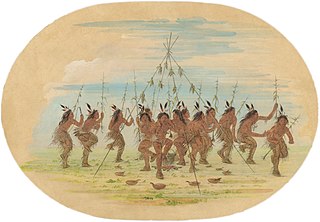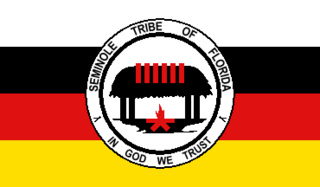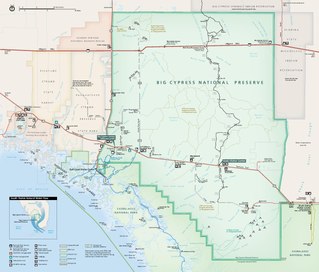Related Research Articles

The Seminoles are a Native American people who developed in Florida in the 18th century. Today, they live in Oklahoma and Florida, and comprise three federally recognized tribes: the Seminole Nation of Oklahoma, the Seminole Tribe of Florida, and the Miccosukee Tribe of Indians of Florida, as well as independent groups. The Seminole people emerged in a process of ethnogenesis from various Native American groups who settled in Spanish Florida beginning in the early 1700s, most significantly northern Muscogee Creeks from what is now Georgia and Alabama.

Brighton Seminole Indian Reservation is an Indian reservation of the Seminole Tribe of Florida, located in northeast Glades County near the northwest shore of Lake Okeechobee. It is one of six reservations held in trust by the federal government for this tribe. The reservation has a land area of approximately 146 square kilometers or 36,000 acres and a 2000 census resident population of 566 persons.

Chikee or Chickee is a shelter supported by posts, with a raised floor, a thatched roof and open sides. Chickees are also known as chickee huts, stilt houses, or platform dwellings. The chickee style of architecture—palmetto thatch over a bald cypress log frame—was adopted by Seminoles during the Second (1835–42) and Third (1855-58) Seminole Wars as U.S. troops pushed them deeper into the Everglades and surrounding territory. Before the Second Seminole War, the Seminoles had lived in log cabins. Similar structures were used by the tribes in south Florida when the Spanish first arrived in the 16th century. Each chickee had its own purpose and together they were organized within a camp-type community. Chickees were used for cooking, sleeping, and eating.

The Green Corn Ceremony (Busk) is an annual ceremony practiced among various Native American peoples associated with the beginning of the yearly corn harvest. Busk is a term given to the ceremony by white traders, the word being a corruption of the Creek word puskita (pusketv) for "a fast". These ceremonies have been documented ethnographically throughout the North American Eastern Woodlands and Southeastern tribes. Historically, it involved a first fruits rite in which the community would sacrifice the first of the green corn to ensure the rest of the crop would be successful. These Green Corn festivals were practiced widely throughout southern North America by many tribes evidenced in the Mississippian people and throughout the Mississippian Ideological Interaction Sphere. Green Corn festivals are still held today by many different Southeastern Woodland tribes. The Green Corn Ceremony typically occurs in late July–August, determined locally by the ripening of the corn crops. The ceremony is marked with dancing, feasting, fasting and religious observations.

The Miccosukee Tribe of Indians of Florida is a federally recognized Native American tribe in the U.S. state of Florida. They were part of the Seminole nation until the mid-20th century, when they organized as an independent tribe, receiving federal recognition in 1962. The Miccosukee speak the Mikasuki language, which is mutually intelligible with the Hitchiti language, is considered its dialect, and is also spoken by many Florida Seminole.
The Mikasuki, Hitchiti-Mikasuki, or Hitchiti language is a language or a pair of dialects or closely related languages that belong to the Muskogean languages family. As of 2014, Mikasuki was spoken by around 290 people in southern Florida. Along with the Cow Creek Seminole dialect of Muscogee, it is also known as Seminole. It is spoken by members of the Miccosukee tribe and of the Seminole Tribe of Florida. The extinct Hitchiti was a mutually intelligible dialect of or the ancestor of Mikasuki.

Miccosukee is a small unincorporated community in northeastern Leon County, Florida, United States. It is located at the junction of County Road 59 and County Road 151. Miccosukee was a major center of the Miccosukee tribe, one of the tribes of the developing Seminole nation, during the 18th century.
Ar-pi-uck-i, also known as Abiaka or Sam Jones, was a powerful spiritual alektca and war chief of the Miccosukee, a Seminole–Muscogee Creek tribe of the Southeast United States. Ar-pi-uck-i successfully defied the U.S. government and refused to remove to the Indian Territory west of the Mississippi and his influential leadership in the Second Seminole War (1835–1842) resulted in the permanent Native American presence in Florida.

The Seminole Tribe of Florida is a federally recognized Seminole tribe based in the U.S. state of Florida. Together with the Seminole Nation of Oklahoma and the Miccosukee Tribe of Indians of Florida, it is one of three federally recognized Seminole entities. It received that status in 1957; today it has six Indian reservations in Florida.

The Seminole Nation of Oklahoma is a federally recognized Native American tribe based in the U.S. state of Oklahoma. It is the largest of the three federally recognized Seminole governments, which include the Seminole Tribe of Florida and the Miccosukee Tribe of Indians of Florida. Its members are descendants of the 3,000 Seminoles who were forcibly removed from Florida to Indian Territory, along with 800 Black Seminoles, after the Second Seminole War. The Seminole Nation of Oklahoma is headquartered in Wewoka within Seminole County, Oklahoma. Of 18,800 enrolled tribal members, 13,533 live in Oklahoma. The tribe began to revive its government in 1936 under the Indian Reorganization Act. While its reservation was originally larger, today the tribal jurisdictional area covers Seminole County, Oklahoma, within which it has a variety of properties.
Phyllis Sheffield was a painter with a history as a documentary photographer of Miccosukee Indians in Florida. As a teenager, she helped photograph the natives living in the Everglades during trips with her aunt Florence (Stiles) Randle. She was born in Miami in 1916. Jeff Klinkenberg wrote about their work and it has been displayed at the Smithsonian. Randle was a WPA photographer. Her work is also in the P.K. Yonge Library of Florida History and the collections of the South Florida Archaeology and Ethnography Program at the Florida Museum of Natural History in Gainesville, Florida. Their work is also included in the Phyllis Sheffield Collection at the Department of Anthropology & Genealogy, Seminole Tribe of Florida.

Ah-Tah-Thi-Ki is a museum of Seminole culture and history, located on the Big Cypress Indian Reservation in Hendry County, Florida. The museum is owned and operated by the Seminole Tribe of Florida. The museum itself was named in a Seminole language phrase: Ah-Tah-Thi-Ki, which means "a place to learn, a place to remember".
William Buffalo Tiger was a political leader of the Miccosukee Nation based in the Everglades area of Florida. He served as the first elected tribal chairman from 1962 to 1985, and before that was head of the General Council from 1957 and a chief. His activism led to political organization of the Miccosukee and their gaining federal recognition in 1962 as an independent Native American tribe. They wrote a constitution to govern their people.
Mickler's Floridiana was a bookseller in Florida started by Thomas Mickler and Georgine Mickler. The couple also ran Mickler House, a small publisher, from their Chuluota, Florida home. They had the largest collection of books on Florida subjects (Floridiana). Some of Mickler's sermon collection now resides at the University of Central Florida Library as the "Thomas and Georgine Mickler Sermon Collection 1880-1933." Thomas Mickler was also an avid map collector. His collection spanned from 1735 to 1995, and covered lands and waterways beyond Florida, as well as providing a historical record of Florida's development.

Bill Osceola was the first president of the Seminole Tribe of Florida. When the federal government marked his tribe for termination, Osceola came up with the idea of creating a rodeo as a tourist attraction to raise funds. The rodeo earned enough money to pay for tribal representatives to lobby against termination and formally organize as a tribe.

Billy Osceola, was the first elected chief of the Seminole Tribe of Florida. He became an ordained minister and was extremely influential in shifting the Seminole Tribe of Florida from traditional spiritual practices to the Baptist faith. He was the first elected chairman of the tribe after their 1957 reorganization.
W. Stanley Hanson (1883–1945) was a photographer, ethnographer, and trusted friend of the Miccosukee and Seminole tribes in South Florida. He served as tax collector and commissioner in Lee County, Florida. The Smithsonian Institution has a collection of his photographs. He also wrote about them and collected artworks from the tribes. He served as Federal Inspector of Birds.

Josie Billie was a Mikasuki-speaking Seminole medicine man, doctor, and Baptist preacher. Billie was a member of the Panther clan of the Seminoles in southern Florida. He actively collaborated with American anthropologists and researchers like Ethel Cutler Freeman, Frances Densmore, Robert Greenlee, Robert Solenberger and William Sturtevant. Billie served as a public spokesman for the Florida Seminoles and created recordings of traditional folk songs and information about the traditional Seminole religion. As of 2017, his camp is part of the Tribal Register of Historic Places.
Seminole patchwork, referred to by Seminole and Miccosukee women as Taweekaache, is a patchwork style made from piecing colorful strips of fabric in horizontal bands. Seminole patchwork garments are often trimmed with a rickrack border. Early examples of this technique are known from photographs in the 1910s, and its use by Seminole women in garment construction began to flourish in the 1920s. Seminole patchwork has historically been an important source of income for many Seminole women, and today remains a source of cultural pride. Fashion designers, including Donna Karan, have been criticized for their appropriation of this patchwork style.
References
- 1 2 Klinkenberg, Jeff (11 February 1996). "Images of a Lost Tribe". Sun Sentinel. Archived from the original on 21 June 2018.
- ↑ "A Cultural Memory: Resistance and Reorganization of the Seminole and Micccosukee Tribes of Southern Florida". Humanities Exchange. Archived from the original on 22 February 2014. Retrieved 20 March 2013.
{{cite web}}: CS1 maint: unfit URL (link) - ↑ "Seminole and Miccosukee History at the P.K. Yonge Library of Florida History". George A. Smathers Library - University of Florida. Archived from the original on 6 March 2008. Retrieved 20 March 2012.
- ↑ "Ethnographic Collections". 7 April 2017.
- ↑ "Downtown Deland Fall Festival of Arts Expecting 75,000".